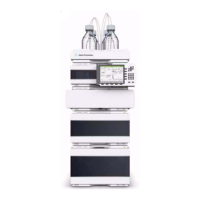Agilent 1200 Infinity Series DAD User Manual 93
Optimizing the Detector
5
Optimizing for Sensitivity, Selectivity, Linearity and Dispersion
Figure 24 Influence of the Slit Width on Baseline Noise
However, with a wider slit, the spectrograph’s optical resolution (its ability to
distinguish between different wavelengths) diminishes. Any photodiode
receives light within a range of wavelength determined by the slit width. This
explains why the fine spectral structure of benzene disappears when using a
8nm wide slit.
Furthermore, the absorbance is no longer strictly linear with concentration
for wavelengths at a steep slope of a compound’s spectrum.
Substances with fine structures and steep slopes like benzene are very rare.
In most cases the width of absorbance bands in the spectrum is more like
30 nm as with anisic acid ( Figure 20 on page 90).
In most situations, a slit width of 4 nm will give the best results.
Use a narrow slit (1 or 2 nm) if you want to identify compounds with fine
spectral structures or if you need to quantify at high concentrations
(> 1000 mAU) with a wavelength at the slope of the spectrum. Signals with a
wide bandwidth can be used to reduce baseline noise. Because (digital)
bandwidth is computed as average of absorbance, there is no impact on linearity.
Use a wide (8 nm) slit when your sample contains very small concentrations.
Always use signals with bandwidth at least as wide as the slit width.
Ha^il^Yi]2-cb
Ha^il^Yi]2&cb
9ViVGViZ2&+%=o

